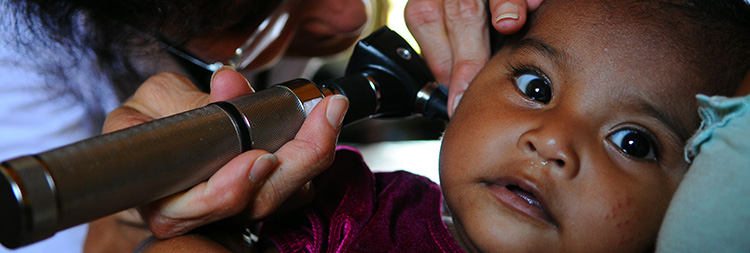Research May Reveal Why Some Ear Infections Refuse To Go Away
(Inside Science) -- Unfortunately for kids with painful ear infections, whatever doesn't kill the bacteria invading their middle ears will only make them stronger.
New laboratory research suggests that antibiotics commonly used to treat ear infections can stimulate certain strains to form "mats," called biofilms, which protect the bacteria from antibiotics. The results may explain why some earaches return, even after multiple rounds of antibiotics.
People come into contact with biofilms all the time. They are the gunk on your teeth after eating candy and the red scum on your unscrubbed tub. But when infectious bacteria form biofilms in the body, they can be especially hard to remove.
Biofilms help bacteria to evade antibiotics by shielding live cells with layers upon layers of dead bacterial cells, which are held together by sticky sugars, proteins, and even long strands of DNA released from the dead microbes. This glue-like mix of materials sticks the cells to one another and to surfaces in the body.
A handful of different bacteria cause ear infections in children. One of the most common culprits is known as non-typeable Haemophilus influenzae, or NTHi. Though it lives peacefully in the nose and throat of many individuals, research has suggested that it is more likely to wreak havoc in the ear after a child has taken antibiotics for any reason. And once a child has a first NTHi ear infection, it will likely come back. Scientists had suspected that bacteria hide out in a protective slime of biofilm during treatment, but these findings are the first to suggest that the antibiotics routinely used to treat ear infections can actually trigger biofilm formation.
In the lab, the researchers exposed different strains of NTHi to three antibiotics commonly prescribed to treat ear infections. Though the bacteria can form biofilms on their own, when exposed to lower, sub-lethal levels of antibiotics, many made bigger, thicker films. This could happen in the body when a person misses a dose, stops treatment early or when inflammation prevents the drugs from reaching the ear fluid.
"If you expose the bacteria to sub-lethal concentrations of the antibiotic while the biofilms are being formed, the bacteria make better biofilms," said the paper's senior author Paul Webster, a biologist who specializes in biofilm research at the University of Southern California in Los Angeles and the Oak Crest Institute of Science in Pasadena, California. The study appeared online July 9 in PLOS ONE.
Perhaps even more concerning, the film protects some strains from an otherwise lethal dose of cefuroxime, one of the stronger antibiotics prescribed for ear infections. Because each strain acted differently, it was impossible to predict which drug would trigger a protective biofilm in a certain strain.
Next, the researchers looked at which genes the bacteria were using while they laid low in the biofilm. The bacteria shut down most of their protein production, but ramped up certain genes needed to make carbohydrates, such as glycogen. Webster thinks that the glycogen both binds the cells together and serves as a food source when the bacteria wake up.
Surprisingly, the cells did not turn on the genes that help them to respond to stress.
"The bacteria were not treating the exposure to antibiotic as a stressful event. They were just closing down their business and waiting for a better time," said Webster.
If certain strains of NTHi form a biofilm in the ear at the first sign of antibiotics, then these findings could have important implications for how doctors treat children with bacterial infections in the ear or elsewhere.
"It's a very elegant piece of research," said Joseph Kerschner, a pediatric ear, nose and throat doctor and dean of the Medical College of Wisconsin in Milwaukee, who was not involved in the new study. But he cautions that it is too early say that this happens in human infections. "The ear is a relatively inaccessible place, so really knowing if that's what happens in humans is a difficult thing."
Replicating these experiments in cell cultures or small mammals, such as the chinchilla, could show whether these biofilms can form on living cells, in spite of the actions of the immune system, says Kerschner.
Webster thinks the medical community needs to approach biofilms as bigger threats to our health than many doctors acknowledge.
"We're not in a position to treat biofilm infections and we're not doing any diagnostic work in biofilm infections," said Webster.
In response to the rise of antibiotic resistance, some pediatricians have begun to hold off on immediate treatment with antibiotics, an approach called "watchful waiting." If the infection doesn't go away in a few days, then the doctor will prescribe a drug.
"The reality is that most ear infections actually -- even if they're bacterial -- will get better just based on the body's own immune system," said Kerschner.
But many parents still want an immediate prescription, just to be safe.
"The take home message is a familiar one," said Luanne Hall-Stoodley, a microbiologist at the Ohio State University College of Medicine in Columbus, who was not affiliated with the research. "You have to be very careful about what antibiotics are used."
Patricia Waldron (@patriciawaldron) is a news intern at Inside Science.

